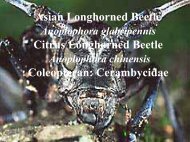You also want an ePaper? Increase the reach of your titles
YUMPU automatically turns print PDFs into web optimized ePapers that Google loves.
Ch14 10/5/99 2:19 PM Page 340<br />
340 CHAPTER 14<br />
side of the Cascades, infection is high in western hemlock and true firs. As previously<br />
discusssed, very little mistletoe occurs on Douglas-fir in this zone. Mistletoe<br />
infections occur in patches in stands and radial spread ranges from 0.3 to 1.5<br />
m/year with significant spread from overstory to understory trees. Fire does not play<br />
an important role in the ecology of hemlock and true fir dwarf mistletoes because<br />
fires are historically so infrequent, occurring only every 200 to 400 years. However,<br />
when large fires did occur, mistletoe incidence was reduced because trees were<br />
killed. Clearcutting in this area is an effective way to control dwarf mistletoe. New<br />
ecosystem management practices, where green trees are retained for wildlife purposes,<br />
however, may increase mistletoe infection because many of the retained trees<br />
are infected with mistletoe, which can easily spread to the understory trees.<br />
On the east side of the Cascade crest, infection is low in western hemlock,<br />
but high in Douglas-fir, lodgepole and ponderosa pine, true firs, and larch. Radial<br />
spread is only 0.5 to 0.7 m/year, but there is significant spread from overstory to<br />
understory. In this region fire plays an important role in the development of dwarf<br />
mistletoes, especially in pine forests. The historically frequent low-intensity fires<br />
here killed small infected trees and reduced the rate of spread. Fire suppression<br />
has caused increased infection in these stands, and the incidence of infection is<br />
now much higher than natural levels. Clearcutting usually is not a viable management<br />
option here. Removal of infected trees will reduce infection in un–evenaged<br />
stands, but these stands must be revisited after a number of years to remove<br />
residual infected trees. Ponderosa pine dwarf mistletoe also may be managed in<br />
thinned or unthinned stands by prescribed understory burns, but scorch heights of<br />
30 to 60% of the crown length are required to significantly reduce dwarf mistletoe<br />
infections. Use of resistant species also is a viable management option.<br />
Chemical control consists of herbicides and growth regulators. Herbicides<br />
have generally proven to be unsuccessful and growth regulators have shown the<br />
most promise. The ethylene-releasing growth regulator Florel, whose active<br />
ingredient is ethephon (2-chloroethyl phosphonic acid) is the only chemical<br />
approved by the EPA for use in the United States. Use of this chemical can delay<br />
seed production by the dwarf mistletoe by 2 to 4 years, reduce the rate of mistletoe<br />
spread, and protect understory trees. However, it cannot cure infected trees<br />
since the endophytic system remains active. Ground spraying of high-value trees<br />
in recreational and residential areas has proven effective, and shoot abscission<br />
rates of 90 to 100% are possible when coverage is thorough. Helicopter spraying<br />
for extensive aerial coverage, however, has proven unsuccessful.<br />
Biological control has promise because many fungi are pathogenic on dwarf<br />
mistletoes and some insects, particularly lepidopteran larvae, feed on dwarf<br />
mistletoes. However, in practice the use of biological control seems remote.<br />
Genetic control has greater potential. In central Oregon small Pinus ponderosa<br />
seedlings produced by grafting scions from Arceuthobium campylopodum–<br />
resistant trees to root stocks were planted in a heavily infected stand. After 20<br />
years high levels of resistance were found in grafts of several selections. Evidence<br />
for host resistance to dwarf mistletoes has been noted in several host-parasite<br />
combinations.

















